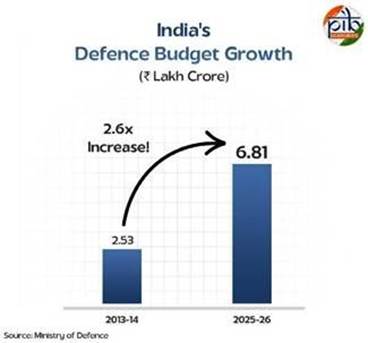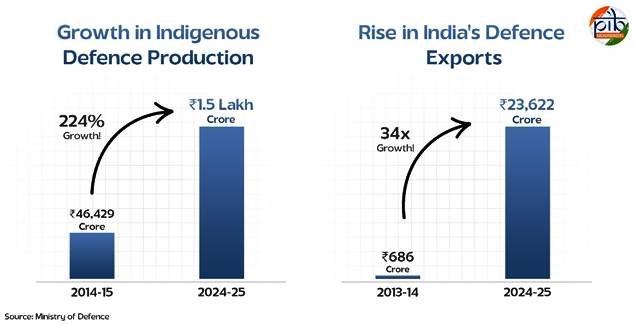Content
- Transformation of India’s Defence and Internal Security Posture
- SCHEMES FOR TRIBAL AREAS
Transformation of India’s Defence and Internal Security Posture
Context & Background
- Pre-2014 Scenario:
- Heavy dependence on imports (India among the top arms importers).
- Defence procurement delays, lack of transparency, and poor private participation.
- Internal security: Left-Wing Extremism (LWE) widespread, frequent terror attacks, porous borders.
- Post-2014 Shift:
- Security framed as non-negotiable.
- Focus on self-reliance (Atmanirbharta), deterrence, and proactive operations.
- Integration of defence with broader national development (technology, economy, food, finance).
Relevance : GS 3(Internal Security , Defence)

Defence Expenditure & Production
- Defence Budget Growth:
- ₹2.53 lakh crore (2013–14) → ₹6.81 lakh crore (2025–26).
- Defence share of GDP remains modest (~2–2.5%) but more efficiently utilised.
- Defence Production:
- Record ₹1.50 lakh crore (2024–25), triple 2014–15.
- Indigenous platforms: fighter jets, missile systems, artillery, warships, carriers.
- Exports: 34x growth; ₹23,622 crore in 2024–25 → exports to 100+ nations (including advanced economies like US, France).

Key Reforms for Self-Reliance
- Defence Acquisition Procedure (DAP) 2020:
- Prioritises Buy (Indian – IDDM) over imports.
- Pushes local design, development, and manufacturing.
- Make in India (Make-I, II, III):
- Make-I: Govt funds up to 70% (₹250 Cr cap).
- Make-II: Industry-funded, inclusive of MSMEs, suo-moto proposals.
- Make-III: Local manufacturing with foreign ToT.
- 146 projects approved across services.
- FDI Liberalisation:
- 74% automatic route.
- 100% govt route for advanced tech.
- Innovation Ecosystem:
- iDEX (2018): Supports start-ups/MSMEs with grants.
- TDF: Up to ₹10 Cr grants for advanced tech.
- 25% defence R&D budget earmarked for non-government actors.
- Indigenisation Portals:
- SRIJAN: 46,798 items listed for local development.
- Positive Indigenisation Lists: 5 tranches, 5,012 items banned for imports.
- Offsets & Strategic Partnerships:
- Offset Portal (2019): transparency in contracts.
- SP Model (2017): Indian firms tie-ups with global OEMs → ToT, infra creation.
Technology Push
- AI & Next-gen Tech:
- Defence AI Council (DAIC), Defence AI Project Agency (DAIPA).
- AI roadmaps for each DPSU.
- DRDO focus areas: Space, Cyber, Robotics, Sensors, Soldier support.
- Future Readiness:
- Sudarshan Chakra Mission (2025): By 2035, develop predictive defence technologies, all-Indian R&D & manufacturing, and national security shield for civilian & strategic assets.
Counter-Terror & Strategic Posture
- Proactive Operations:
- 2016 Uri → Surgical Strikes.
- 2019 Pulwama → Balakot Air Strikes.
- 2025 Pahalgam (Operation Sindoor): Drone strikes on 9 terror camps, 100+ terrorists eliminated.
- Five “New Normals” on Pakistan (PM Modi’s doctrine):
- Firm, decisive responses to terror.
- No tolerance of nuclear blackmail.
- Terrorists = Sponsors equally culpable.
- Talks only on terrorism & PoJK.
- No compromise on sovereignty (terror & talks/trade mutually exclusive).
Internal Security Stabilisation
- Left-Wing Extremism (LWE):
- 2010: 1,936 incidents → 2024: 374 incidents.
- Casualties (civilian + security) down by 85%.
- Fewer than 20 affected districts (down from ~90+).
- 8,000+ Naxalites surrendered/rehabilitated.
- Approach: Security + Development.
- Infrastructure (roads, telecom, schools) in LWE zones.
- Welfare schemes expanded to previously cut-off regions.
National Security Beyond Defence
- Food Security:
- Production: 246 MT (2013–14) → 354 MT (2024–25).
- PMGKAY: 81 Cr beneficiaries of free food grains.
- PM-KISAN: ₹3.9 lakh crore disbursed to farmers.
- Financial Security:
- FI-Index: 67.0 (2025), +24% since 2021.
- 89% account ownership (Global Findex 2025).
- PMJDY: 56 Cr beneficiaries, ₹2.64 lakh crore balance.
- Dairy & Fisheries:
- Milk: 146 MT → 239 MT (2014–24).
- Fisheries: 96 LT → 195 LT (2014–25).
- India = World’s largest milk producer, inland fish production doubled.
- Technology & Industry:
- India Semiconductor Mission (₹76,000 Cr, 2021).
- First 3nm chip design centres in Noida & Bengaluru (2025).
- First indigenous chip ready for production (2025).
Strategic Impact
- Shift in Global Image:
- From passive security stance to assertive regional power.
- From top importer to emerging exporter.
- Greater autonomy in policy due to reduced defence import dependence.
- Doctrinal Evolution:
- Preventive, not just reactive, posture.
- Integrated view of security: defence, economy, energy, food, finance.
- Security = foundation for Viksit Bharat 2047.
Conclusion
- India’s defence & internal security transformation (2014–2025) is structural, not cosmetic.
- Key pillars: Atmanirbharta, Innovation, Deterrence, Proactivity, Comprehensive Security.
- Achievements: Rising global exporter, technological self-reliance, reduced LWE & terror vulnerability, integrated national resilience.
- Overall → India today speaks and acts from a position of strength, aiming for Viksit Bharat with a security doctrine that fuses hard power, economic resilience, and technology leadership.
SCHEMES FOR TRIBAL AREAS
Context & Constitutional Framework
- Scheduled Tribes (STs): Identified under Article 342 of the Constitution; development of STs is a constitutional commitment.
- Directive Principles: Article 46 directs the State to promote educational and economic interests of weaker sections, especially STs.
- Special Provisions:
- Article 275(1): Special Central Assistance (SCA) as grants to states with ST population for welfare.
- Fifth Schedule: Administration of Scheduled Areas.
- Sixth Schedule: Autonomous District Councils in NE states.
Relevance : GS 1(Society) , GS 2(Social Justice , Governance)
Institutional Mechanism for Tribal Development
- Ministry of Tribal Affairs (MoTA): Nodal Ministry for ST development.
- Development Action Plan for Scheduled Tribes (DAPST):
- Strategy where 41 Ministries/Departments earmark part of their budget for tribal development.
- Focus: bridging ST vs non-ST gaps in education, health, agriculture, skill, infrastructure.
- Coordination: MoTA ensures convergence of schemes across line ministries.
Major Schemes / Programmes (Core + Flagship)
- Dharti Aaba Janjatiya Gram Utkarsh Abhiyan (2024–29):
- PM-launched; 25 interventions, 17 Ministries.
- Target: Saturate 63,843 villages in 30 States/UTs; benefit 5 crore tribals.
- Budget: ₹79,156 Cr (Centre: ₹56,333 Cr; States: ₹22,823 Cr).
- Focus: Health, education, Anganwadi infra, livelihoods.
- Pradhan Mantri Janjati Adivasi Nyaya Maha Abhiyan (PM-JANMAN, 2023–26):
- Launched on 15 Nov 2023 (Janjatiya Gaurav Divas).
- Outlay: ₹24,000 Cr.
- Focus: Particularly Vulnerable Tribal Groups (PVTGs).
- Goals: Safe housing, clean water, sanitation, road/telecom connectivity, electrification, health, nutrition, livelihood.
- Pradhan Mantri Janjatiya Vikas Mission (PMJVM):
- Merged schemes: MSP for Minor Forest Produce (MFP) + Marketing of Tribal Products.
- Features:
- MSP fixation & procurement for MFP.
- Sustainable collection & value addition.
- Market intelligence + value chain infra.
Education & Human Resource Development
- Eklavya Model Residential Schools (EMRS):
- Started in 2018–19.
- Target: 728 schools (1/block with >50% ST population & ≥20,000 STs).
- Beneficiaries: 3.5 lakh ST students.
- Scholarships:
- Pre-Matric (IX–X):
- Income ≤ ₹2.5 Lakh/year.
- Day scholars: ₹225/month; Hostellers: ₹525/month.
- Funding: 75:25 (Centre:State); 90:10 for NE + Hilly States.
- Post-Matric:
- Income ≤ ₹2.5 Lakh/year.
- Reimbursement of compulsory fees + stipend (₹230–₹1200/month).
- Same funding ratio.
- National Overseas Scholarship: 20 awards/year (17 STs, 3 PVTGs). Income ≤ ₹6 Lakh.
- National Fellowship (MPhil/PhD) & Top Class Education (IITs, IIMs, AIIMS, etc.): 750 fellowships/year; income limit ≤ ₹6 Lakh.
- Pre-Matric (IX–X):
Social Security & Welfare
- National Social Assistance Programme (NSAP):
- Includes STs.
- Indira Gandhi National Old Age Pension Scheme (IGNOAPS): BPL persons aged ≥60 years.
- Grant-in-Aid to Voluntary Organizations:
- For education, health, hostels, dispensaries, livelihood.
Research, Culture & Heritage
- Support to Tribal Research Institutes (TRIs):
- Activities: Research, training, documentation, tribal museums, cultural promotion.
- 100% funding by MoTA.
West Bengal – Fund Flow Snapshot (2022–25)
Education Scholarships
- Pre-Matric:
- 2022–23: ₹29.89 Cr.
- 2023–24: Data NA.
- 2024–25*: Provisional (yet to be updated).
- Post-Matric:
- 2022–23: ₹34.06 Cr.
- 2023–24: ₹35.00 Cr.
- 2024–25*: Provisional.
Development of PVTGs
- 2022–23: ₹665.95 Lakh.
- 2023–24: ₹0 (gap year).
- 2024–25*: ₹1631.05 Lakh.
NSTFDC Loans (Tribal Finance & Development)
- 2022–23: ₹1643.33 Lakh.
- 2023–24: ₹1526.59 Lakh.
- 2024–25*: ₹2233.75 Lakh.
Pradhan Mantri Adi Adarsh Gram Yojana (PMAAGY)
- 2022–23: ₹3495.20 Lakh.
- 2023–24: ₹0.00.
- 2024–25*: ₹0.00.
Article 275(1) Grants
- 2022–23: ₹4186.5 Lakh.
- 2023–24: ₹4744.4 Lakh.
- 2024–25*: ₹3549.61 Lakh.
Grant-in-Aid to NGOs
- 2022–23: ₹476.1 Lakh.
- 2023–24: ₹1167.79 Lakh.
- 2024–25*: ₹1390.18 Lakh.
Eklavya Model Residential Schools (EMRS)
- 2022–23: ₹2303.67 Lakh.
- 2023–24: ₹1869.70 Lakh.
- 2024–25*: ₹1789.50 Lakh.
Key Observations
- Shift to Mission Mode: PM-JANMAN & Dharti Aaba Abhiyan show convergence-driven, saturation-based development targeting infrastructure + livelihood.
- Focus on PVTGs: Dedicated budget lines & saturation approach within 3 years.
- Education Push: EMRS expansion + multi-tier scholarship architecture (school to PhD + overseas).
- Financial Inclusion: NSTFDC loans growing steadily; tribal entrepreneurship focus.
- Fund Utilization (West Bengal):
- Fluctuations visible (e.g., PVTG funds dropped to zero in 2023–24; PMAAGY halted after 2022–23).
- Scholarships & EMRS grants consistent but modest.
- Article 275(1) funds steady with small decline in 2024–25.
Overall Takeaways
- Tribal policy has moved from welfare-based → rights-based → saturation & mission-mode convergence.
- Emphasis on education, livelihood, infrastructure, and PVTG inclusion.
- Persistent challenge: irregular fund flow & inter-year fluctuations (esp. in WB).
- Strong role of constitutional provisions (275(1), 5th & 6th Schedule) + DAPST convergence strategy.
- Key trend: Integration of tribal development with mainstream growth via MSP, EMRS, skill, and infrastructure.



